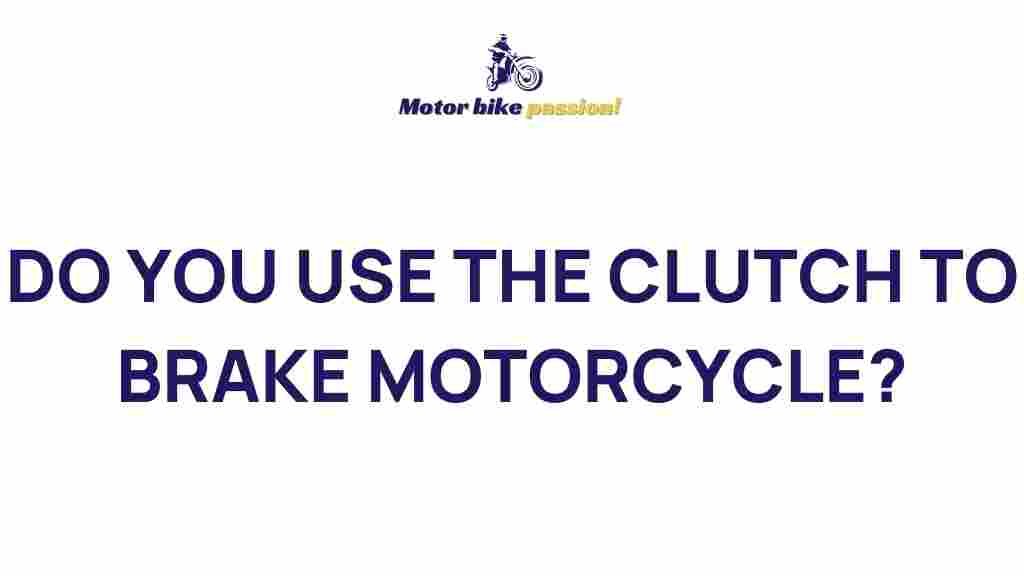When it comes to riding a motorcycle, mastering different techniques can dramatically enhance your control, efficiency, and safety. One such skill is clutchless braking, a method that many riders overlook but offers a myriad of advantages. In this article, we will explore the benefits of clutchless braking, how to do it correctly, and address common challenges riders face when implementing this technique.
What Is Clutchless Braking on Your Motorcycle?
Clutchless braking is a method of slowing down or stopping your motorcycle without disengaging the clutch. Instead of pulling the clutch lever, you rely on a combination of the front and rear brakes, allowing the engine’s compression to contribute to the braking process. This approach not only reduces wear on your clutch but also improves overall handling and safety.
Why Should You Consider Clutchless Braking?
Many riders are accustomed to using the clutch during braking, but clutchless braking can provide numerous advantages:
- Improved Control: Clutchless braking allows for smoother deceleration, especially in low-traction conditions.
- Enhanced Efficiency: Reduces wear on clutch components, prolonging their lifespan.
- Safety Benefits: Keeps the motorcycle stable during sudden stops, minimizing the risk of a skid.
- Fuel Economy: By leveraging engine braking, fuel consumption can be slightly optimized.
How to Perform Clutchless Braking Safely
Learning clutchless braking on a motorcycle involves a systematic approach. Follow these steps to ensure safe and effective execution:
- Start at Low Speeds: Begin practicing clutchless braking in a controlled environment, such as an empty parking lot.
- Engage Both Brakes: Use both the front and rear brakes to slow down your motorcycle. This ensures balanced deceleration.
- Leverage Engine Braking: Release the throttle gradually and let the engine’s compression assist in slowing the bike.
- Monitor Gear Engagement: Ensure your current gear is appropriate for the speed to avoid stalling the engine.
- Practice, Practice, Practice: Consistent practice will make the process second nature and increase your confidence.
Common Challenges and How to Overcome Them
Riders new to clutchless braking may encounter certain difficulties. Here’s how to tackle them:
- Stalling: If the engine stalls, ensure you are not trying to brake from high speeds in low gears. Shift down gradually while braking.
- Jerky Movements: Smoothly release the throttle and apply the brakes evenly to avoid a jerky ride.
- Over-reliance on Front Brake: Balance the use of front and rear brakes to maintain stability.
When to Use Clutchless Braking
Clutchless braking is particularly useful in specific scenarios, such as:
- Descending Hills: Engine braking helps control speed without overheating the brakes.
- Wet or Slippery Roads: Offers better traction management compared to sudden braking with the clutch engaged.
- Emergency Stops: Provides quicker reaction times by bypassing the clutch lever.
How Clutchless Braking Benefits Your Motorcycle’s Longevity
Using clutchless braking can extend the life of your motorcycle in several ways:
- Reduces clutch wear by minimizing unnecessary disengagement.
- Prevents brake overheating during prolonged use, especially in downhill riding.
- Optimizes fuel consumption by leveraging engine compression.
For more tips on maintaining your motorcycle in peak condition, check out our comprehensive guide.
Expert Tips for Mastering Clutchless Braking
Here are some advanced tips to help you perfect this technique:
- Gear Anticipation: Always anticipate the gear you’ll need as you slow down.
- Brake Feel: Familiarize yourself with the responsiveness of your front and rear brakes.
- Routine Practice: Include clutchless braking in your regular riding drills to build muscle memory.
Want to learn about other advanced riding techniques? Explore this external guide on expert motorcycle skills.
Troubleshooting Common Issues with Clutchless Braking
If you experience challenges while implementing clutchless braking, these solutions can help:
- Unintended Skidding: Check your tire pressure and ensure even brake application.
- Loud Engine Sounds: Shift gears appropriately to avoid over-revving.
- Motorcycle Feels Unstable: Ensure your suspension and braking system are in good condition.
Conclusion
Clutchless braking is a valuable skill that every motorcycle rider should consider mastering. It enhances control, improves safety, and prolongs the lifespan of your bike’s components. While it requires practice and patience, the benefits far outweigh the initial learning curve. Whether you’re a seasoned rider or a beginner, integrating this technique into your routine will undoubtedly elevate your riding experience.
Ready to take your skills to the next level? Discover other ways to optimize your motorcycle performance today!
This article is in the category Safe Driving and created by MotorBikePassion Team
